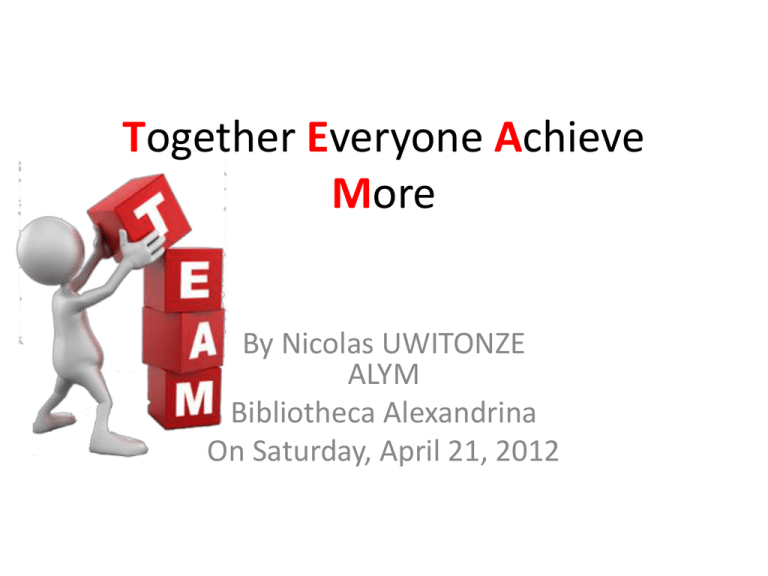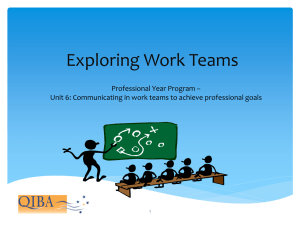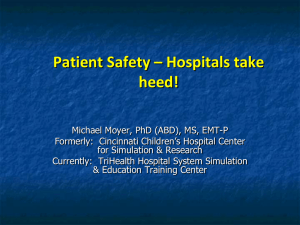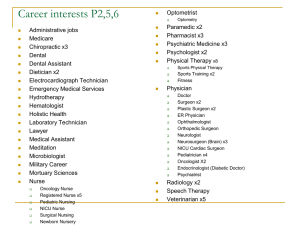Together Everyone Achieve More
advertisement

Together Everyone Achieve More By Nicolas UWITONZE ALYM Bibliotheca Alexandrina On Saturday, April 21, 2012 CONTENT I. What is Teamwork? II. Why should we be interested in team work? III. What is the Difference Between a Group work and a Teamwork? IV. Characteristics of Effective Teams V. Stages of Team Growth I. What is Teamwork? Teamwork is defined in Webster's New World Dictionary as "a joint action by a group of people, in which each person subordinates his or her individual interests and opinions to the unity and efficiency of the group.“ The most effective teamwork is produced when all the individuals involved harmonize their contributions and work towards a common goal. From Wikipedia, the free encyclopedia Teamwork is an action performed by a team towards a common goal. A team consists of more than one person, each of whom typically has different responsibilities. A team also includes seven common elements: 1. common purpose; 2. interdependence; 3. clear roles and contributions; 4. satisfaction from mutual working; 5. mutual and individual accountability; 6. realization of synergies; and 7. empowerment II. Why should we be interested in team work? • Teamwork has become an important part of the working culture and many businesses now look at teamwork skills when evaluating a person for employment. • Most companies realize that a better product will result when a team approach is taken in work requiring multiple skills • Also, research tells us that students learn best from tasks that involve doing tasks and involve social interactions. III. What is the Difference Between a Group work and a Teamwork? Group work Team work Members work independently and they often are not working towards the same goal. Members work interdependently and work towards both personal and team goals, and they understand these goals are accomplished best by mutual support. Members focus mostly on themselves because they are not involved in the planning of their group's objectives and goals. Members feel a sense of ownership towards their role in the group because they committed themselves to goals they helped create. Members are given their tasks or told what their duty/job is, and suggestions are rarely welcomed. Members collaborate together and use their talent and experience to contribute to the success of the team's objectives. Members are very cautious about what they say and are afraid to ask questions. They may not fully understand what is taking place in their group Members base their success on trust and encourage all members to express their opinions, varying views, and questions. Group work Teamwork Members do not trust each other's Members make a conscious effort to be motives because the do not fully honest, respectful, and listen to every understand the role each member plays in person's point of view their group. Members may have a lot to contribute but are held back because of a closed relationship with each member. Members are encouraged to offer their skills and knowledge, and in turn each member is able contribute to the group's success Members are bothered by differing opinions or disagreements because they consider it a threat. There is not group support to help resolve problems. Members see conflict as a part of human nature and they react to it by treating it as an opportunity to hear about new ideas and opinions. Everybody wants to resolve problems constructively. Members may or may not participate in group decision-making, and conformity is valued more than positive results. Members participate equally in decisionmaking, but each member understands that the leader might need to make the final decision if the team can not come to a consensus agreement. IV. Characteristics of Effective Teams The following are eight characteristics of effective teams the were identified by Larson and LaFasto in their book titled Teamwork: What Must Go Right/What Can Go Wrong(Sage Publications 1989): 1) 2) 3) 4) The team must have a clear goal. Avoid fuzzy, motherhood statements. Team goals should call for a specific performance objective, expressed so concisely that everyone knows when the objective has been met. The team must have a results-driven structure. The team should be allowed to operate in a manner that produces results. It is often best to allow the team to develop the structure. The team must have competent team members. In the education setting this can be take to mean that the problem given to the team should be one that the members can tackle given their level of knowledge. The team must have unified commitment. This doesn't mean that team members must agree on everything. It means that all individuals must be directing their efforts towards the goal. If an individual's efforts is going purely towards personal goals, then the team will confront this and resolve the problem. 5) 6) 7) 8) The team must have a collaborative climate. It is a climate of trust produced by honest, open, consistent and respectful behavior. With this climate teams perform well...without it, they fail. The team must have high standards that are understood by all. Team members must know what is expected of them individually and collectively. Vague statements such as "positive attitude" and "demonstrated effort" are not good enough. The team must receive external support and encouragement. Encouragement and praise works just as well in motivating teams as it does with individuals. The team must have principled leadership. Teams usually need someone to lead the effort. Team members must know that the team leader has the position because they have good leadership skills and are working for the good of the team. The team members will be less supportive if they feel that the team leader is putting him/herself above the team, achieving personal recognition or otherwise benefiting from the position. V. Stages of Team Growth. • It is important for teacher and students (the team members) to know that teams don't just form and immediately start working together to accomplish great things. There are actually stages of team growth and teams must be given time to work through the stages and become effective. Team growth can be separated into four stages. References http://www.ndt-e d.org/TeachingResources /ClassroomTips/Teamwork.htm accessed on 4/19/2012 8:30 PM http://www.audubon-area.org /56Slides / 56sld018.htm accessed on 4/19/2012 8:30 PM http://www.lindsay-sherwin.co.uk/guide_ team_leadership/ tml_team_development /2_team_development.htm accessed on 4/19/2012 8:32 PM YOUR KIND ATTENTION DESERVES...




![Teamwork [doc]](http://s3.studylib.net/store/data/007119492_1-4f52bf0b0aa8b7482c84777d359de0b7-300x300.png)






